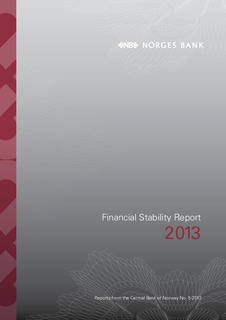| dc.contributor.editor | Olsen, Øystein | |
| dc.date.accessioned | 2018-09-19T07:34:07Z | |
| dc.date.available | 2018-09-19T07:34:07Z | |
| dc.date.issued | 2013 | |
| dc.identifier.issn | 1502-2749 | |
| dc.identifier.issn | 1503-8858 | |
| dc.identifier.uri | http://hdl.handle.net/11250/2563337 | |
| dc.description | Financial stability implies a financial system that is resilient to shocks and is capable of channeling funds, executing payments and distributing risk efficiently. Financial stability is one of Norges Bank’s primary objectives in the work on promoting economic stability. Norges Bank’s tasks and responsibilities in this area are set out in Section 1 of the Norges Bank Act, which states that the Bank shall “promote an efficient payment system domestically as well as vis-à-vis other countries”. Section 3 states that “the Bank shall inform the Ministry of Finance when, in the opinion of the Bank, there is a need for measures to be taken by others than the Bank in the field of monetary, credit or foreign exchange policy”. The central bank can provide extraordinary liquidity to individual institutions in the financial sector or to the banking system when liquidity demand cannot be satisfied from alternative sources. As the bankers’ bank Norges Bank monitors the financial system as a whole, with particular focus on the risk of systemic failure. Banks play a key role in credit provision and payment services and they differ from other financial institutions in that they rely on customer deposits for funding. An assessment of the risk of financial instability is based on a broad analysis of banks, the structural framework and economic developments that may give rise to shocks. The annual Financial Stability Report takes a closer look at the banks’ situation and longer-term, structural features of importance for financial stability. Financial imbalances and the banking sector are assessed in Norges Bank’s Monetary Policy Report with financial stability assessment in conjunction with Norges Bank’s monetary policy assessments and the decision basis for the countercyclical capital buffer for banks. The Financial Stability Report for 2013 was presented to the Executive Board at its meeting on 4 December. | nb_NO |
| dc.language.iso | eng | nb_NO |
| dc.publisher | Norges Bank | nb_NO |
| dc.relation.ispartofseries | Financial Stability Report;2013 | |
| dc.relation.ispartofseries | Reports from the Central Bank of Norway;No. 5-2013 | |
| dc.rights | Attribution-NonCommercial-NoDerivatives 4.0 Internasjonal | * |
| dc.rights.uri | http://creativecommons.org/licenses/by-nc-nd/4.0/deed.no | * |
| dc.title | Financial Stability Report 2013 | nb_NO |
| dc.type | Report | nb_NO |
| dc.description.version | publishedVersion | nb_NO |
| dc.subject.nsi | VDP::Samfunnsvitenskap: 200::Økonomi: 210::Samfunnsøkonomi: 212 | nb_NO |
| dc.source.pagenumber | 51 | nb_NO |

